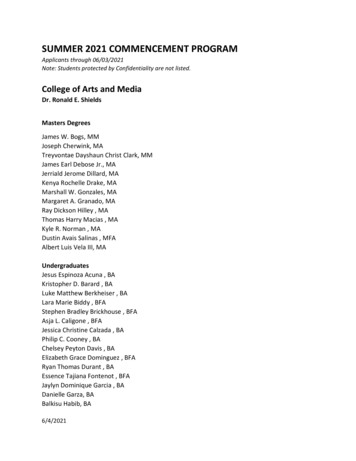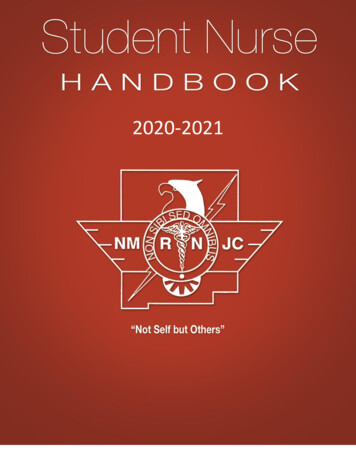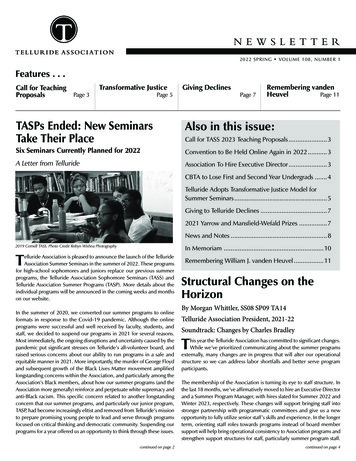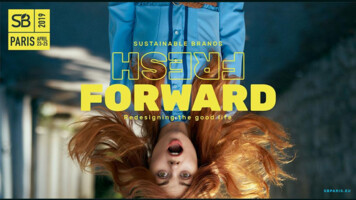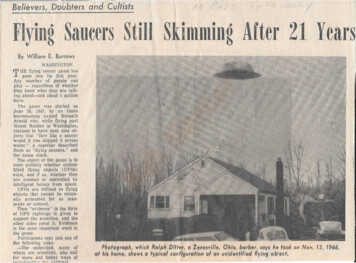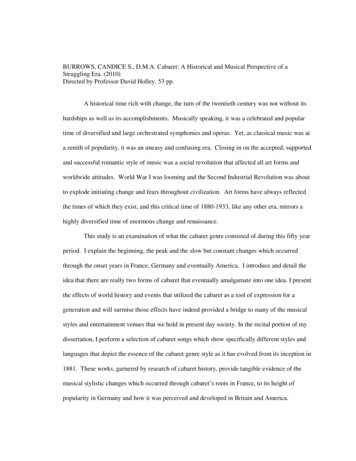
Transcription
BURROWS, CANDICE S., D.M.A. Cabaret: A Historical and Musical Perspective of aStruggling Era. (2010)Directed by Professor David Holley. 53 pp.A historical time rich with change, the turn of the twentieth century was not without itshardships as well as its accomplishments. Musically speaking, it was a celebrated and populartime of diversified and large orchestrated symphonies and operas. Yet, as classical music was ata zenith of popularity, it was an uneasy and confusing era. Closing in on the accepted, supportedand successful romantic style of music was a social revolution that affected all art forms andworldwide attitudes. World War I was looming and the Second Industrial Revolution was aboutto explode initiating change and fears throughout civilization. Art forms have always reflectedthe times of which they exist, and this critical time of 1880-1933, like any other era, mirrors ahighly diversified time of enormous change and renaissance.This study is an examination of what the cabaret genre consisted of during this fifty yearperiod. I explain the beginning, the peak and the slow but constant changes which occurredthrough the onset years in France, Germany and eventually America. I introduce and detail theidea that there are really two forms of cabaret that eventually amalgamate into one idea. I presentthe effects of world history and events that utilized the cabaret as a tool of expression for ageneration and will surmise those effects have indeed provided a bridge to many of the musicalstyles and entertainment venues that we hold in present day society. In the recital portion of mydissertation, I perform a selection of cabaret songs which show specifically different styles andlanguages that depict the essence of the cabaret genre style as it has evolved from its inception in1881. These works, garnered by research of cabaret history, provide tangible evidence of themusical stylistic changes which occurred through cabaret‟s roots in France, to its height ofpopularity in Germany and how it was perceived and developed in Britain and America.
CABARET: A HISTORICAL AND MUSICAL PERSPECTIVE OF A STRUGGLING ERAbyCandice S. BurrowsA Dissertation Submitted tothe Faculty of the Graduate School atThe University of North Carolina at GreensboroIn Partial Fulfillmentof the Requirements for the DegreeDoctor of Musical ArtsGreensboro2010Approved byCommittee Chair
APPROVAL PAGEThis dissertation has been approved by the following committee of the Faculty of TheGraduate School at The University of North Carolina at Greensboro.Committee ChairDavid HolleyCommittee MembersAshley BarretJames DouglassLevone Tobin ScottDate of Acceptance by CommitteeDate of Final Oral Examinationii
ACKNOWLEDGEMENTSTo my children, Caitlin, Gretchen and Grady Hemm, for being present throughout thislong journey, and to my parents, Charles and Mary Burrows who have exemplified unconditionallove and support. I also wish to thank Daniel Turner and John and Diane Nulty for their truefriendship and unending support. Their faith and constant encouragement are too valuable not tomention here for they are my Godly warriors. Lastly, I wish to thank my doctoral committee,Professor David Holley, Professor Levone Tobin Scott, Dr. Ashley Barret and Dr. JamesDouglass. My undergraduate degree taught me how to be a student; my masters taught me howto be a performer and my doctoral degree has taught me how to be a teacher. Thank you all.iii
PREFACEIn the process of deciding my topic area for this lecture recital, I felt it important to utilizeexperiences and certainly interests in my own past as a vocalist. My musical education beganwith musical theater and singing jazz with the University of Oregon Faculty Jazz Band. Later,while working toward my Bachelor of Music degree, I found a much bigger and more rewardingchallenge in classical music. Though my career blossomed professionally with opera andoratorio, I always knew that at some time I would return to my jazz beginnings.Cabaret, with some classical and jazz influences, mirrors my own classical and jazzbackground. Musically, it has many jazz characteristics, including (but not limited to) a sense offreedom in rhythmic license, vocal production, staging when applicable and of courseimprovising. In contrast, many notable and respected composers of the more classical style ofmusic have regarded cabaret as something to address. Therefore, there exist cabaret songs whichappear to be written under the numerous sub-genre categories of theater music, also known asCommercial Contemporary Music (CCM). There also exist other cabaret songs which fall underthe musical category of legitimate art song to which I refer as a more classical style.My intent and goal is to examine how these two opposing styles of singing can somehowbe combined and proven capable of existing in the same concert. I have chosen to search foranswers through an examination of the history of cabaret and compositional practices of the time.During my research, I have examined historical events worldwide, vocal performance practices,literary influences and visual arts reflective of the time leading me to the conclusion that cabaretwas far more than a genre of music or even a specific type of performance venue. Rather, it wasthe cry of a generation hurting and confused, its cry refusing to be ignored, but rather demandingto be heard as it struggled with the injustices, social and political that pervaded the time.iv
Eventually the cabaret, which can be labeled a genre of performing art and also a type ofperformance venue, was simply a tool: a multifaceted vehicle used with the intent of “beingheard” and promoting change. Some of the greatest artists and minds of the time were its greatestsupporters.v
TABLE OF CONTENTSPageLIST OF FIGURES . viiCHAPTERI. INTRODUCTION . 1II. CABARET‟S FRENCH BEGINNINGS . 4Montmartre and the Hydropathes . 5III. KABARETT: THE MOVE TO GERMANY . 11World Events and Influences on Kabarett . 12IV. STYLES. 16Song Content Categories . 18Musical Differences between Classical and Cabaret . 20The Ten Commandments of Cabaret Life . 21V. INFLUENCES ON AMERICA . 23Americas Gilded Age and Jazz Infancy . 23Cabaret‟s Commonalities with Jazz . 25The “Beat Generation”. 26VI. SONG CHOICES . 29Les Chemins de L‟Amour. 29La Diva de L‟Empire . 31Gigerlette . 34Prolog. 37Tell Me The Truth About Love . 40Amor . 42Waitin . 44Black Max . 45VII. CONCLUSION . 48BIBLIOGRAPHY . 50vi
LIST OF FIGURESPageFigure 1. Le Chat Noir, 1906 . 5Figure 2. Jane Avril at the Jardin de Paris. By Henri de Toulouse Lautrec, 1893 . 6Figure 3. Tournée du Chat Noir. By Theophile Steinlen, 1896 . 8Figure 4. Ambassadeurs: Aristide Bruant dans son Cabaret. By Henri deToulouse Lautrec, 1892 . 9Figure 5. Yvette Guilbert, 1913 . 12Figure 6. Buntes Theater, Berlin, 1901 . 36vii
CHAPTER IINTRODUCTIONMusicologists and music historians have struggled to agree on the major questionssurrounding the birth of cabaret. Author and performer Debra Tedrick calls it the “when,” “how,”“why,” and “who” questions linked with that influential and rather short-lived genre.1 As oneunderstands what cabaret is and what it is not, it becomes evident that there are simply too manyfactors integrated within its description to completely understand how cabaret originated.Supplying a significant influence on the arts and the political mores that dominated the majorityof Europe around the turn of the twentieth-century, cabaret is ever illusive to a true and concretedescription. The interpretation of this rich institution is rooted in complex cultural history of late19th century France, and the distance of a century indeed presents difficulties in imagining the“flavor” of this past-time.2 This all occurred after the Franco-Prussian War (1870-1871), whenthe French were trying to regain their sense of self and declare their individuality again.The significance of these findings indicates that much of our entertainment today hasbeen birthed because of the cabaret years of 1881-1933. There was an appeal, a draw, even a “jene sais quoi” according to the French that captured the attention of western civilization during itsfifty year life span. That generation discovered there was a power in satire, sarcasm, honesty andhumor – all common requirements of cabaret. Likewise, our present entertainment has continuedusing those same power tools which cabaret utilized. One need only observe the prevalent and1Tedrick, Deborah Lynne. Black cats, Berlin, Broadway and beyond: The genre of cabaret. M.F.A.dissertation, University of Central Florida, Dissertations & Theses: 2006. p.402Fields, Armond. Le Chat Noir: A Montmartre Cabaret and Its Artists in turn-of the Century Paris.Santa Barbara, CA: Santa Barbara Museum of Art 1993.1
unmistakable sarcasm and/or humor that is thrown at political figures every election year tobecome aware of the cabaret influence.Musically speaking, the two styles of singing, which can be plainly recognized as aclassical style and a popular (CCM) style are simply that: two styles of singing. Sung separatelyor combined, they can be placed in one concert. In order for these styles to be effective, thesinger must be knowledgeable of the vocal practices used in each while presenting a goodcommand of healthy vocal technique and a passion to share the genre with an audience. AuthorWolfgang Ruttkowski states that cabaret songs represent a “certain style of performance ratherthan a song, even though obviously not every kind of text can be performed as a cabaret song.”3The popularity and importance of cabaret was a combination of many varied factorsincluding a musical venue to vent about social and political injustices as well as a platform for thevoice of the common and educated man to provide discussion and feedback within the “cabaret”setting. These factors primarily led to empowering people. Its significance is grounded in theclear recognition that the arts, how and where they were performed, not only proved powerfulenough to initiate change but also reflected the emotional status of a society.The choice of song repertoire for this lecture recital was selected by simple terms ofvariety of music, ranges, texts, and varying languages. The composers Erik Satie (1866-1925)and Francis Poulenc (1899-1963) represent the French contribution of cabaret. Satie was highlyinvolved in the Montmartre cabaret and Poulenc, the composer who was a young man whencabaret faded from its peak years, was still highly affected by its style. The German composerschosen to represent the kabarett, Kurt Weill (1900-1950) and Arnold Schoenberg (1874-1951),3Ruttkowski, Wolfgang. “Cabaret Songs.” Popular Music and Society. Vol.25, no.3/4 (2001, Fall andWinter). p. 452
provide evidence of some musical changes from the French cabaret as it became a hugeinfluential political power. Lastly, the English speaking composers, Benjamin Britten (19131976) and William Bolcom (1938- ) seem to derive their compositional ideas by referring to thecommonalities of cabaret contents: humor, mood songs, prostitute songs, and ballad-like stories.3
CHAPTER IICABARET‟S FRENCH BEGINNINGSThe simple description of cabaret was initially worded as, “a business that served liquor.”It was much more than that, and due to its growing popularity more cabarets began to open uparound Paris. In the late 1880‟s, a simple rural area of Paris (Montmartre district) evolved,becoming a home for artists and entertainment. This was the beginning of the golden age ofcabaret, which lasted approximately fifty years. It ended in 1933 when political crises in Europeput an end to freedom of thought and expression, the traits cabaret exuded in its most exaggeratedform.4 It was there that poor artists, people of high culture, doctors, bankers, journalists, poetsand anyone who had a desire for intellectual banter could escape.Even in modern times, the names of some are recognizable, such as the Moulin Rougewhich was also located in the red light district of Montmartre in 1889. Many of theseestablishments featured scheduled entertainment that ranged in size from large, full floor shows,(though not in the early years) to individual soloists. Cabaret expert and author Lisa Appignanesisimplifies an order of musical venues which preceded and led to cabaret. Starting with the Bistroor Café, the main focus was the solitary singer. Soon the idea of costumes, props and minimalstaging emerged as the Café-Concert came into being. Full scale bands and larger audienceswere implemented next; this new venue was referred to as the Music Hall. Their focus was4The New Grove Dictionary of Music and Musicians, 2nd ed., s.v. “Cabaret”4
entertainment.5 In contrast, cabaret reversed the growing pattern of bigger and biggerentertainment by focusing on intimacy and very specific artistic goals.Montmartre and the HydropathesAll music historians agree on the location of the first acknowledged cabaretestablishment. Le Chat Noir (The Black Cat), founded by Rodolphe Salis, opened as the firstcabaret on November 18, 1881 in the bohemian Montmartre district of Paris.6 Salis, a strugglingpainter, found himself fascinated with Montmartre and the cheaper rents there. With the financialaid of his father and the encouragement of new-found friends in theHydropathes Society (an artistic group united by their love of poetryand “modern ideas” that found a home at Le Chat Noir with the soleintent of shocking people and delighting one another), he decided toopen Le Chat Noir as a place for the Hydropathes to meet weeklyand support local artists. (Figure 1) It was a private, secret societythat held closed meetings and performances so that they could firstFigure 1: Le Chat Noir, 1906recite to each other and second, entertain one another7.Word spread quickly regarding the Hydropathes Society, making Le Chat Noir all themore alluring to the public. This society proved that the cabaret was more than music or songsand alcohol, a common belief held by the general society of the time. It was a free haven, a type5Appignanesi, Lisa. The Cabaret. New Haven: Yale University Press, 2004. p.56Ibid., p.11. Montmartre was considered a rural area for social outcasts, calling themselves thecanaille, the rabble, snubbing the bourgeoisie and known for their famous windmills in the outlying areas.7Tedrick. p. 40-415
of permission for artists to perform anything that made a statement. The Bistros and CaféConcerts showcased costumed singers, using props and singing love lyrics and/or mood songs.These venues provided a way to report current events while entertaining, but the Hydropathesexpanded that idea by adopting songs (Chansons) while adding a satirical twist which proved it tobe a powerful protest song. Historically, these songs were vehicles for the “initial elements ofcabaret.”8A trendy characteristic of the cabaret was its ability to combine varied art forms, thuscreating new art forms. This trait acted as a catalyst fornumerous entertainment performance venues as well as artform genres. Historian, Peter Jelavich writes, “all aspectsof cabaret were always morphing and changing”9 leadingmore artists to participate. Some performing artists hadcelebrity status and were featured on posters, such asactor/singer Aristide Bruant, or Henri de Toulouse-Lautrecwhose paintings and name are synonymous with theFrench Cabaret. Toulouse Lautrec painted dancer/actress,Jane Avril so often that her high leg kick with rufflesflowing made her an iconic representative of cabaret.(Figure 2)Figure 2 : Jane Avril at the Jardin deParis. By Henri de Toulouse Lautrec,1893The Black Cat was a familiar character in French folklore and represented a figure that“punished disobedient children and sometimes acted like a seductive lover. More recently it8Ibid. p.409Jelavich, Peter. Berlin Cabaret. Cambridge, MA: Harvard University Press. 1993. p.36
became a symbol for artistic freedom in Montmartre.”10 It is believed that Salis chose the title torepresent the era of prominent symbolism. The sexual connotations of the cat advertised to thecommunity that there were other facets to this establishment. In total, the message from Salissuccessfully permeated the attention of Paris and the long term outcome highlighted social andpolitical opinions through entertainment provided.Imagine this setting! A small café or corner restaurant in Paris it comes alive only atnight and you walk in. There are a handful of tables. It is fairly dark but you can see paintingsby Toulouse-Lautrec on the tattered walls. Clinking glasses, smoke and laughter fill the room asyou seat yourself at a table in front of someone presenting a bawdy poem. He finishes. Peoplerespond with laughter and an emcee introduces a small ensemble of instrumentalists who begin toplay what appears to be a simple folk tune with a strong dance-like rhythm the singer joins in.Her text is a humorous tale about prostitution. Following the song, another presenter stands upand recites a poem. It is sarcastic, funny and very honest regarding some injustice of thegovernment and how they keep asking for more taxes. There is always some type of discussionthat follows each of the many presenters. Some patrons even take it upon themselves to arguetheir personal views with performers. Welcome to the Cabaret!The popularity of Le Chat Noir on the artistic world exposed a deep desire to delve intoentertainment for other reasons than pure entertainment. Cabaret influenced the visual, musicaland literary arts and left a permanent mark on the power of said arts. Author Robert Henningstates:10Fields, Armond. Le Chat Noir: A Montmartre Cabaret and Its Artists in Turn-of-the-centruy Paris.Santa Barbara,CA: Santa Barbara Museum of art, 1993. This excerpt is taken from the Forward by The AssistantDirector for Curatorial Services7
Through camaraderie, the stimulation of new and audacious ideas, the lively mixture ofall professions and classes of people, artists found a sympathetic ambience for theircreative impulses the Chat Noir pervaded the art world of its time. It has left a legacywhich we honor here. 11Le Chat Noir (Figure 3) became the “place to be” and, as the addiction to this sanctuarygrew, famous artistic patrons also grew in numbersincluding French painters, Adolphe Willette, HenriRivière and the iconic Henri de Toulouse-Lautrec.Toulouse-Lautrec became so enamored and fascinatedwith the cabaret movement, he incorporated cabaretperformers in many of his works of the period. Thepolitical satirist and caricaturist André Gill andnumerous French poets such as Paul Verlaine andJules Laforgue were only a few of the literary giantsthat frequented her doorsteps. Representing the worldof music were some of the great French composers ofFigure 3: Tournée du Chat Noir. ByTheophile Steinlen, 1896the period, Claude Debussy, Erik Satie, Charles Cros,Jules Laforgue and a young Francis Poulenc. The more notable actors included Coquelin Cadet,the high stepping Jane Avril (Figure 2)12 and Aristide Bruant (Figure 4), to name only a religiousfew.11Ibid. This excerpt is taken from the Forward by The Assistant Director for Curatorial Services.12Toulouse-Lautrec, Henri de. Jane Avril at the Jardin de Paris. 1893. The poster in Fig. 2 is ofdancer/actress Jane Avril (1868-1943) who was made one of the most recognizable dancers of the cabaret due toToulouse-Lautrec who painted her regularly.8
The draw to the cabaret and its popularity wasundeniable. By 1900 the craze spread to other areasof France. Cabarets were multiplying and theirlocations and atmospheres within played a role in thedescription of a true cabaret. The rooms had to besmall and intimate as there were never large crowdsable to fit in the facilities. This enabled a close groupand easy banter or “discussion.” The ensemblesFigure 4 : Ambassadeurs: Aristide Bruant dansson Cabaret. By Henri de Toulouse-Lautrec,1892consisted of a few wind instruments, piano and adrum.The initial purpose of cabaret was to provide a small venue for entertainment and drinks.It was an attempt to follow the “Variety Show” originated in the English Music Halls. This samevenue was mimicked in America with the name “Vaudeville.”13 However, cabaret brought a newtype of intimacy not found in more traditional music venues. People sat at cozy candlelit tables,drinks in hand, while performers worked among them, sometimes joining them at their tables andinteracting or conversing.14 People felt comfortable in this atmosphere and their singularopinions on any given number of subjects were valued and expected. This new venue separatedthe cabaret from other types of traditional entertainment because it was delightfully intellectual.Lisa Appignanesi states:13Jelavich, Peter. Berlin Cabaret. Cambridge, MA: Harvard University Press. 1993. p. 2014Kenrick, John. Musicals101.Com The Cyber Encyclopedia of Musical Theatre, TV and Film. S.l: s.n.1996-2003. http://www.musicals101.com9
Growing out of the café concert (Music Hall), the cabaret was, from its inception in1881,immediately a more intellectual and self-consciously artistic form, though laughter andentertainment were of its essence.15Clearly there were many draws to this venue, but in the end, cabaret was a great escape,the escape from compulsory political, religious, economical, sexual and social mores forced uponthe people. These mores were scrutinized, routinely challenged and always presented throughsatire, irony and well prepared humor.15 15Appignanesi. p.510
CHAPTER IIIKABARETT: THE MOVE TO GERMANYSince cabaret became a political voice, it was inevitable that its influences would becarefully monitored by Germany. Prior to 1900, Germany utilized a hierarchical ladder ofauthority. The “yes-man” (conforming to the social and political norm) was encouraged andpolitical disaffection followed. Corruption was prevalent; there existed a somber sense of duty tofamily, church, business and state.16 The French and their free spirit were completelymisunderstood by the Germans, or if understood, they were scoffed at as lower class. Thisbecame more evident as cabaret took on “a more aggressively political character” when itflourished in Germany.17 The German Kabarett, also referred to as cabaret with a K, was about“breaking the rules.” The rumors of a new art form coming out of France, and the bohemiannature of cabaret, helped launch new thinking for the Germans. Albert Langen started the weeklysatirical magazine, Simplicissimus (1896)18, which was politically daring and unapologeticallybrash. Though new to German thinking, it was welcomed by the commoners in society and was agood venue for voicing social and political injustices that were being experienced in theireveryday lives. Partly due to the influences of Nietzsche and his views on philistinism (incontradiction, he valued art and challenged political and social norms), the Germans slowly beganto consider that humor and alcohol consumption could be considered more allowable.16Appignanesi. p.3617Bateman, Marlene Titus. The Cabaret Songs, Volume One of William Bolcom and Arnold Weinstein:An Exploration and Analysis. Ann Arbor, MI: UMI Dissertation Services., 2002. p. 52.18Appignanesi. p.3711
World Events and Influences on KabarettThe Second Industrial Revolution occurred between 1875-1905, rapidly changingworldwide economics. These changes, clearly believed to be advancements, combined witheconomic and social unrest to lead to instability andmore political controls. Between 1876 and 1903 alone,Alexander Graham Bell invented the telephone, ThomasEdison invented the incandescent light bulb, RudolfDiesel patented the diesel engine, Guglielmo Marconiinvented the wireless telegraph and the Wright brothersmade their first successful airplane flight. In addition tothese events, there were significant changes withinworldwide politics which propelled unrest andeventually led to World War I (1914-1918). Ageneration struggled to keep up with the plethora ofFigure 5: Yvette Guilbert, 1913advancements and although it had an effect on the arts,it had a more significant effect on society.The arts became a needed outlet for a sense of community and assurance. The Germankabarett became more than a source of entertainment; it became a needed voice of courage,representing the power of the people and a reflection of their concerns.The famous French cabaret diseuse, Yvette Guilbert (1865-1944), took a concert tourthrough Germany in 1902 (Figure 5). This served to get the attention of the German people andtheir desperate need for entertainment that ventured outside the walls of conventionality.Kabarett concentrated more on use of the diseuse (female monologue entertainer) andrelied on regular poetry as well as ballad-like tunes. The ballad usually consisted of numerous12
verses in strophic form, telling a story. The music therefore took second seat to the texts. Inaddition, due to Guilbert, the use of more body involvement and facial expression becameexpected. In the concert hall or professional stage, the voice‟s primary importance was beauty ofsound. Now the voice was a tool for expression and “Sprechstimme” was commonplace.19 Inthe French cabaret beginnings, the freedom of the voice to be used with untrained techniques wasaccepted as part of the charm, but “Sprechstimme” (the use of speech type singing) was initiatedand perfected in the German kabarett.The German artists dedicated themselves almost completely to political and/or socialtopics where they were able to criticize using cynicism, sarcasm and irony. The Germans wantedthe best of two worlds. On the one hand, it was a very proud time for German composers in theclassical world of music where their works were prolific and highly successful. Yet, other peoplewere drawn to this apparent shallow folk music or popular song forms (kabarett) which wasdeeply satisfying because of its literary content; the kabarett flourished.As in Paris, the first German kabarett, Überbrettl20, was founded in 1901 and thenbranched off into many other smaller venues beginning in Berlin. As the Weimar Republic cameto power, it ended most forms of censorship, and kabarett enjoyed a time of unmitigated freedom.However, during that era (1919-1933), the Nazi regime, which eventually came into power in1933, attempted to annihilate the art form. This forced many performing artists to escape to thesafety of other countries such as America.2119The New Grove Dictionary of Music and Musicians, 2 nd ed., s.v. “Cabaret”20Appignanesi. p. 3821Tedrick, Debra Lynne. p.2. The Weimar Republic was the name given by historians to theparliamentary republic established in Germany to replace the imperial form of government, named after Weimar(1919).13
Kabarett‟s horizons broadened, often adding elements such as partial or full nudity. TheWeimar Era was decadent, lascivious, and lewd, as it utilized the freedom that censorship denied.It continued to deal with contemporary society, political and social commentary. The kabarettwas also enamored with sexual content, particularly homosexual themes. Like burlesque, kabarettutilized lewd humor and bawdy performances. It was an “anything goes” atmosphere.22 DebraLynne Tedrick states:Whe
Some of the greatest artists and minds of the time were its greatest supporters. vi TABLE OF CONTENTS . flavor of this past -time.2 This all occurred after the Franco-Prussian War (1870 . seem to derive their compositional ideas by referring to the commonalities of cabaret contents: humor, mood songs, prostitute songs, and ballad-like .


